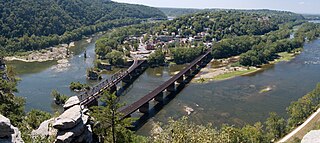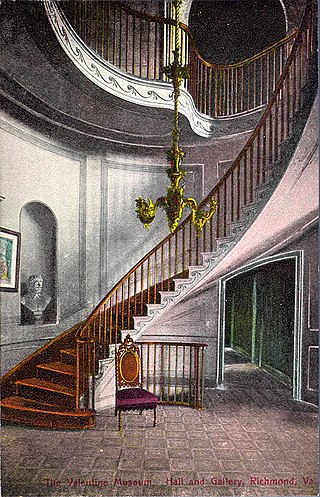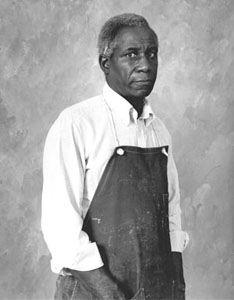
Monticello was the primary plantation of Thomas Jefferson, a Founding Father and the third president of the United States, who began designing Monticello after inheriting land from his father at age 14. Located just outside Charlottesville, Virginia, in the Piedmont region, the plantation was originally 5,000 acres (20 km2), with Jefferson using the labor of African slaves for extensive cultivation of tobacco and mixed crops, later shifting from tobacco cultivation to wheat in response to changing markets. Due to its architectural and historic significance, the property has been designated a National Historic Landmark. In 1987, Monticello and the nearby University of Virginia, also designed by Jefferson, were together designated a UNESCO World Heritage Site. The current nickel, a United States coin, features a depiction of Monticello on its reverse side.

Richmond is the capital city of the Commonwealth of Virginia in the United States. Incorporated in 1742, Richmond has been an independent city since 1871. The city's population in the 2020 census was 226,610, up from 204,214 in 2010, making it Virginia's fourth-most populous city. The Richmond metropolitan area, with 1,260,029 people, is the Commonwealth's third-most populous.

Lynchburg is an independent city in the Commonwealth of Virginia in the United States. First settled in 1757 by ferry owner John Lynch, the city's population was 79,009 at the 2020 census, making Lynchburg the 11th most populous city in Virginia. Located in the foothills of the Blue Ridge Mountains along the banks of the James River, Lynchburg is known as the "City of Seven Hills" or the "Hill City". In the 1860s, Lynchburg was the only city in Virginia that was not recaptured by the Union before the end of the American Civil War.

Monument Avenue is a tree-lined grassy mall dividing the eastbound and westbound traffic in Richmond, Virginia, originally named for its emblematic complex of structures honoring those who fought for the Confederacy during the American Civil War. Between 1900 and 1925, Monument Avenue greatly expanded with architecturally significant houses, churches, and apartment buildings. Four of the bronze statues representing J. E. B. Stuart, Stonewall Jackson, Jefferson Davis and Matthew Fontaine Maury were removed from their memorial pedestals amidst civil unrest in July 2020. The Robert E. Lee monument was handled differently as it was owned by the Commonwealth, in contrast with the other monuments which were owned by the city. Dedicated in 1890, it was removed on September 8, 2021. All these monuments, including their pedestals, have now been removed completely from the Avenue. The last remaining statue on Monument Avenue is the Arthur Ashe Monument, memorializing the African-American tennis champion, dedicated in 1996.

The Virginia Museum of History and Culture founded in 1831 as the Virginia Historical and Philosophical Society and headquartered in Richmond, Virginia, is a major repository, research, and teaching center for Virginia history. It is a private, non-profit organization, supported almost entirely by private contributions. In 2004, it was designated the official state historical society of the Commonwealth of Virginia.

Harpers Ferry National Historical Park, originally Harpers Ferry National Monument, is located at the confluence of the Potomac and Shenandoah rivers in and around Harpers Ferry, West Virginia. The park includes the historic center of Harpers Ferry, notable as a key 19th-century industrial area and as the scene of John Brown's failed abolitionist uprising. It contains the most visited historic site in the state of West Virginia, John Brown's Fort.

The African American Museum in Philadelphia (AAMP) is notable as the first museum funded and built by a municipality to help preserve, interpret and exhibit the heritage of African Americans. Opened during the 1976 Bicentennial celebrations, the AAMP is located in historic Philadelphia on Arch Street, a few blocks away from the Liberty Bell. It was formerly known as the Afro-American Historical and Cultural Museum.

The Maggie L. Walker National Historic Site is a United States National Historic Landmark and a National Historic Site located at 110½ E. Leigh Street on "Quality Row" in the Jackson Ward neighborhood of Richmond, Virginia. The site was designated a U.S. National Historic Landmark in 1975. The National Historic Site was established in 1978 to tell the story of the life and work of Maggie L. Walker (1867-1934), the first woman to serve as president of a bank in the United States. It was built by George W. Boyd, father of physician, Sarah Garland Boyd Jones. The historic site protects the restored and originally furnished home of Walker. Tours of the home are offered by National Park Service rangers.

Jackson Ward, previously known as Central Wards, is a historically African-American district in Richmond, Virginia, with a long tradition of African-American businesses. It is located less than a mile from the Virginia State Capitol, sitting to the west of Court End and north of Broad Street. It was listed as a National Historic Landmark District in 1978. "Jackson Ward" was originally the name of the area's political district within the city, or ward, from 1871 to 1905, yet has remained in use long after losing its original meaning.

The Valentine is a museum in Richmond, Virginia dedicated to collecting, preserving and interpreting Richmond's history. Founded by Mann S. Valentine II 1898, it was the first museum in Richmond.

The Museum of the American Revolution, formerly The American Revolution Center, is a museum in Philadelphia, Pennsylvania dedicated to telling the story of the American Revolution. The museum was opened to the public on April 19, 2017, the 242nd anniversary of the Battles of Lexington and Concord, some of the battles of the American Revolutionary War, on April 19, 1775.

First Battalion Virginia Volunteers Armory, is a historic armory building located in Richmond, Virginia. It was built in 1895, and is a two-story. Late Victorian style brick structure. It also is known as the Leigh Street Armory, the Monroe School, and the Monroe Center.
Funky Turns 40: Black Character Revolution (2012–2017) was an American traveling exhibition featuring animation artwork representing black characters from 1970s cartoons. It was compiled by co-curators Pamela Thompson and Loreen Williamson. The two women have collected more than 300 pieces of work related to classic cartoons and animated feature films; the traveling exhibition showcases 60 of these, including drawings, cels, posters, and storyboards.
The Thomas Jefferson Foundation, originally known as the Thomas Jefferson Memorial Foundation, is a private, nonprofit 501(c)(3) corporation founded in 1923 to purchase and maintain Monticello, the primary plantation of Thomas Jefferson, the third president of the United States. The Foundation's initial focus was on architectural preservation, with the goal of restoring Monticello as close to its original appearance as possible. It has since grown to include other historic and cultural pursuits and programs such as its Annual Independence Day Celebration and Naturalization Ceremony. It also publishes and provides a center for scholarship on Jefferson and his era.

Howard Lee Baugh was an American military aviator who served with the Tuskegee Airmen during World War II.

The Jefferson Davis Memorial was a memorial for Jefferson Davis (1808–1889), president of the Confederate States of America from 1861 to 1865, installed along Richmond, Virginia's Monument Avenue, in the United States. The monument was unveiled on Davis' birthday, June 3, 1907, a day celebrated in Virginia and many other Southern states as Confederate Memorial Day. It consisted of a bronze statue of Davis by Richmond sculptor Edward Valentine surrounded by a colonnade of 13 columns represented the Southern states, and a tall Doric column topped by a bronze statue, also by Valentine, representing Southern womanhood.
Tufton Farm, located in Albemarle County, Virginia, borders the Monticello plantation. The farm was passed down from Peter Jefferson to his son Thomas Jefferson, whose grandson Thomas Jefferson Randolph inherited the property. Thomas Jefferson experimented with plants and sustainable farming. It is now the site of the Thomas Jefferson Center for Historic Plants.
Adolph Dill, also known as Addolph Dill, was an American businessman, landowner, and baker during the Antebellum era in Richmond, Virginia. The Confederate States Army took over Dill's bakery to supply soldiers in 1864, re-naming it the "C. S. Bakery".

Benjamin Leroy Wigfall (1930–2017) was an American abstract-expressionist painter, printmaker, teacher, gallery owner, and collector of African art. He was the founder of a community art space called Communications Village as a hub for residents in a Black neighborhood in Kingston, New York. At the age of 20, he was the youngest artist ever to have a painting purchased by the Virginia Museum of Fine Arts.

















